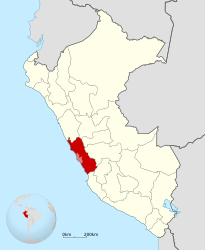Lima region
| Lima region | |||
|---|---|---|---|
| Symbols | |||
|
|||
| Basic data | |||
| Country | Peru | ||
| Capital | Huacho | ||
| surface | 32,129.3 km² | ||
| Residents | 780,881 (2005 estimate) | ||
| density | 24 inhabitants per km² | ||
| ISO 3166-2 | PE-LIM | ||
| Website | www.regionlima.gob.pe (Spanish) | ||
| politics | |||
| Gobernador regional | Ricardo Chavarría Oria (2019-2022) |
||
| Provinces of the Lima region | |||
Coordinates: 11 ° 2 ′ S , 77 ° 33 ′ W
The Lima Region [ lima ] ( span . Región Lima or Departamento de Lima , also Lima Provincias ) is a region in central Peru . Its provisional capital is Huacho .
geography
The region includes the Pacific coast around the Peruvian capital Lima , which is not itself part of the region, as well as the adjacent part of the central Peruvian Andes .
The mountainous landscape brings out some mountains over 4000 meters. The highest mountain is the Morococha with 5182 meters.
There are numerous islands off the coast, the largest of which are San Lorenzo, El Frontón , Pachacamac, Corcovado and Asia.
history
When the Spanish viceroyalty of Peru became the Republic of Peru, the Spanish directorships of Peru were converted into seven departments in 1821: Arequipa, Ayacucho, Cusco, Junín, La Libertad, Lima and Puno. The city of Lima remained as the capital of the new Republic of Peru, as well as the department of the same name. The department was again divided into 11 provinces (see below): Barranca, Cajatambo, Canta, Cañete, Huaral, Huarochirí, Huaura, Oyón, Callao (spun off in 1836) and Lima City (spun off in 2002).
In the 2001 congressional elections, Lima, the most populous constituency, had 35 of a total of 120 members in the Peruvian parliament . In March 2002 under President Alejandro Toledo Manrique , the Peruvian constitution was reformed and decentralization was classified as constitutionally relevant and permanent state policy . On July 17th, 2002 by law No. 27783 "Fundamentals of Decentralization", among other things, all competences and tasks of a regional government were transferred to the municipal administration of the Lima city province. As a result, the Lima City Province is separated from the Lima Region and its seat of government has been the city of Huacho since then. As of the parliamentary elections in 2011 , the Lima region has only 4 members of the 130 national parliament (while Lima city has 33).
In October 2002, national elections were held for the first time to form the respective regional governments. The first president of the Lima region was Miguel Ángel Muffarech Nemy (in office January 1, 2003 - December 31, 2006) from APRA .
Provinces
The region is divided into nine provinces.
| province | Capital |
|---|---|
| Barranca | Barranca |
| Cajatambo | Cajatambo |
| Canta | Canta |
| Cañete | San Vicente de Cañete |
| Huaral | Huaral |
| Huarochirí | Matucana |
| Huaura | Huacho |
| Oyón | Oyón |
| Yauyos | Yauyos |
Web links
- http://www.regionlima.gob.pe/ Regional government of the Lima Provincias region




